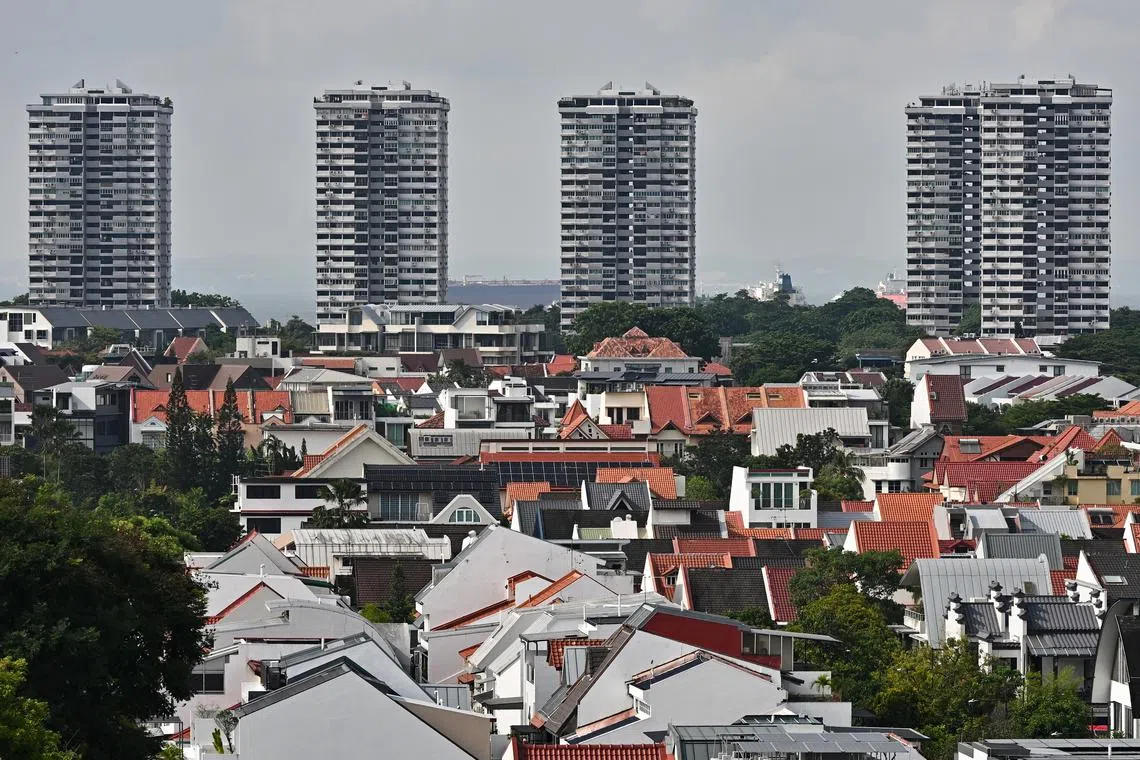Private residential home prices up 1% in Q2: URA
Sign up now: Get ST's newsletters delivered to your inbox

Reflecting a more cautious sentiment, new sales transactions (excluding ECs) plummeted 64 per cent to 1,212 units in the second quarter of 2025, from 3,375 units in the first quarter.
PHOTO: ST FILE
Follow topic:
- Private residential prices in Singapore rose 1% in Q2 2025, exceeding initial estimates, supported by landed property gains despite economic uncertainties.
- New sales declined as developers delayed launches due to "ongoing trade frictions, rising geopolitical tensions and an uncertain economic outlook."
- Resale volumes increased 2.3%, while rentals rose 0.8%. City fringe prices fell, attributed to "realistic pricing" of new projects.
AI generated
SINGAPORE – Private residential home prices rose 1 per cent in the second quarter of 2025, with growth in prices of landed property outperforming that of the non-landed segment.
This is above flash estimates of 0.5 per cent released earlier in July, and a 0.8 per cent gain in the previous quarter.
But it is a slower pace compared with the 2.3 per cent jump in the fourth quarter of 2024, latest data from the Urban Redevelopment Authority (URA) showed.
Reflecting a more cautious sentiment, new sales transactions (excluding executive condominiums or ECs) plummeted 64 per cent to 1,212 units in the second quarter of 2025, from 3,375 units in the first quarter.
Buyers retreated to the sidelines, while some developers held back launches in the face of an uncertain economic outlook triggered by global trade tensions. June is also traditionally a quiet month for private home launches because of the school holidays.
Some 1,520 uncompleted private residential units, excluding ECs, were launched for sale in the second quarter, down from 3,139 units in the previous quarter, according to URA data released on July 25.
Sub-sales dipped 16.2 per cent to 269 deals from 321 in the first quarter.
Ms Chia Siew Chuin, JLL’s head of residential research, noted that the share of sub-sales to total sales rose to 5.2 per cent in the second quarter, from 4.4 per cent in the first.
But this is below the 7.9 per cent recorded in the second quarter of 2024.
Total unsold inventory rose slightly by 2.1 per cent quarter on quarter to 18,653 units, but it remains below the 10-year annual average of 22,452 units, said Mr Wong Xian Yang, Cushman & Wakefield’s head of research for Singapore and South-east Asia.
This means that while new launches are expected to be priced competitively given the higher pipeline in 2025, developers are unlikely to lower prices significantly as the unsold inventory remains low and development costs are elevated, he said.
On the other hand, resale volumes edged up 2.3 per cent to 3,647 units in the second quarter, from 3,565 units in the first, as these units remain comparatively affordable against newly launched units and meet the needs of those who need to move in immediately.
Driving the second quarter’s overall price growth were stronger landed property prices and a 3 per cent jump in non-landed property prices in the prime district, up from a 0.8 per cent rise in the first quarter.
Realion Group chief researcher and strategist Christine Sun attributed the growth in prime district non-landed home prices to more transactions done at above $4,000 per sq foot (psf), including some at above $5,000 psf in Sculptura Ardmore, Skywaters Residences and ultra-luxe launch 21 Anderson.
Landed home prices gained 2.2 per cent in the second quarter, up from a 0.4 per cent rise in the previous quarter, after 11 good class bungalow deals valued at more than $300 million were lodged in the second quarter, up from just two caveated deals in the first quarter, according to Huttons Asia chief executive Mark Yip.
Prices of non-landed homes grew at a slower pace of 0.7 per cent in the second quarter, compared with a 1 per cent gain in the previous quarter.
In the city fringe, prices fell 1.1 per cent compared with a 1.7 per cent rise in the previous quarter, while the suburban market jumped 1.1 per cent compared with a 0.3 per cent increase in the first quarter.
Ms Tricia Song, head of research for South-east Asia at CBRE, attributed the city fringe sub-market’s underperformance to developers’ “realistic pricing” for new launches, One Marina Gardens and Bloomsbury Residences.
One Marina Gardens sold 353 units or 38 per cent of its units at an average price of $2,953 psf over its launch weekend in April.
Bloomsbury Residences in one-north moved 151 units or 42 per cent at a median price of $2,470 psf in the second quarter – some 3 per cent lower than the median price of $2,546 psf at The Hill @ One North, an earlier launch, Ms Song added.
Meanwhile, the private rental market rose 0.8 per cent in the second quarter, up from a 0.4 per cent growth in the preceding quarter, as rentals continued to stabilise.
The private rental market may take longer than expected to fully recover, due to macroeconomic uncertainties surrounding the global trade wars, Ms Sun said.
“Some companies could slow down on expat hiring. Nevertheless, the lower interest rates may bode well for businesses, as financing costs are reduced,” she added.
Rentals of non-landed properties in the prime district rose 1.8 per cent in the second quarter, compared with a 0.4 per cent gain in the previous quarter, while those in the city fringe remained unchanged after a 0.4 per cent rise in the previous quarter.
In the suburban market, rentals rose 0.1 per cent in the second quarter, compared with a 0.7 per cent increase in the previous quarter.


